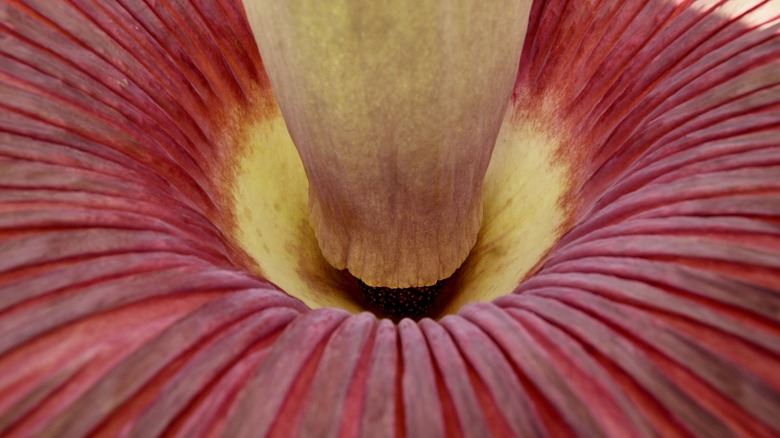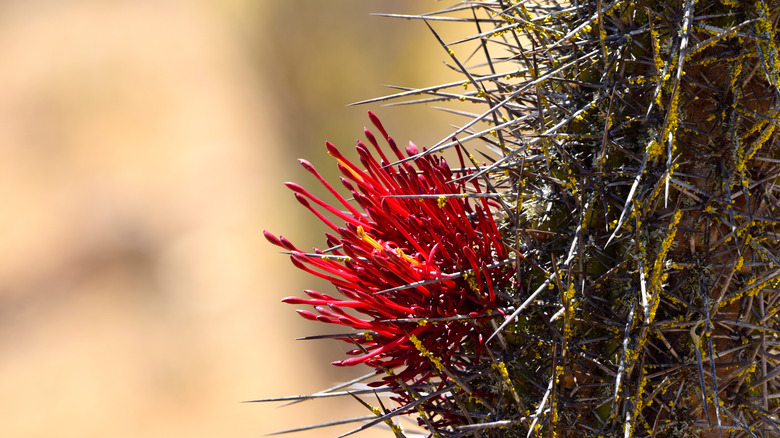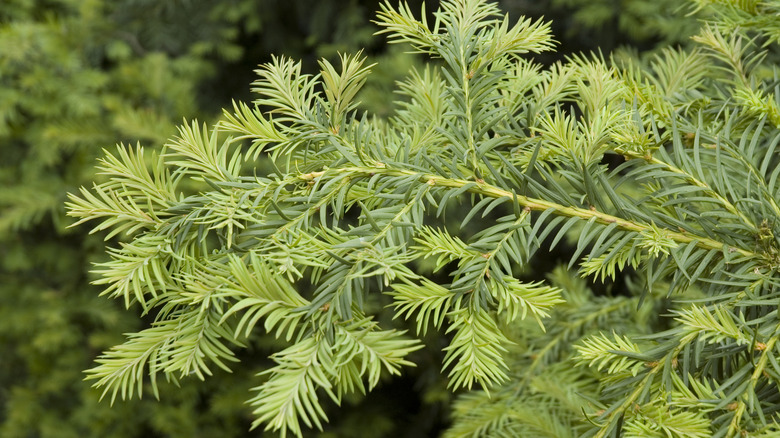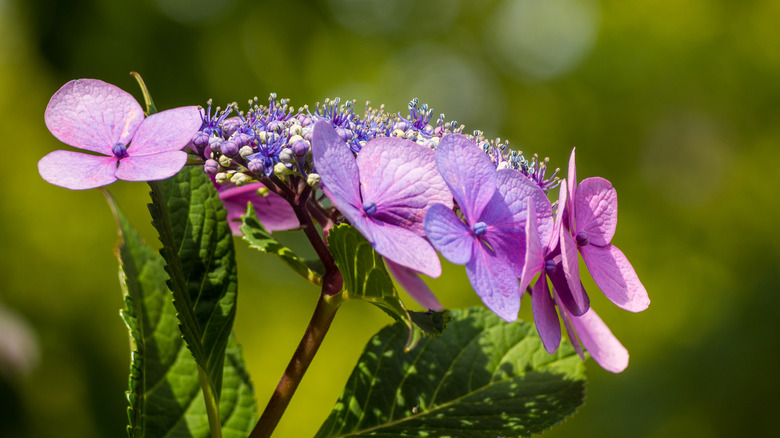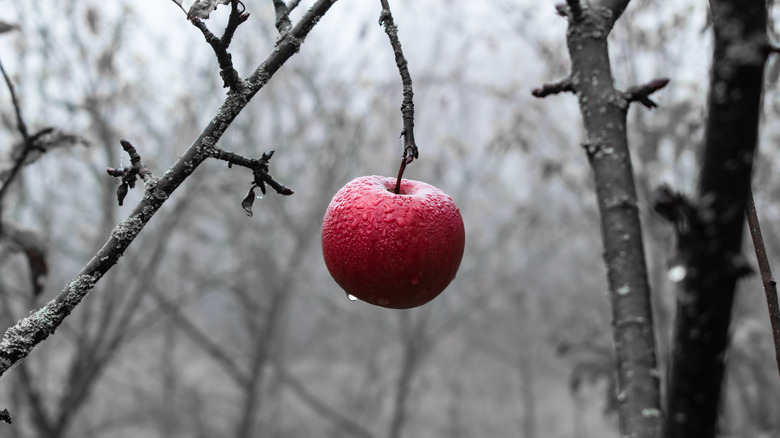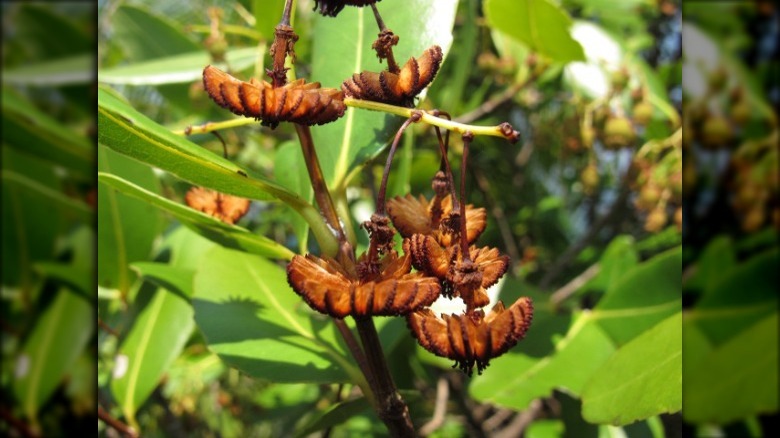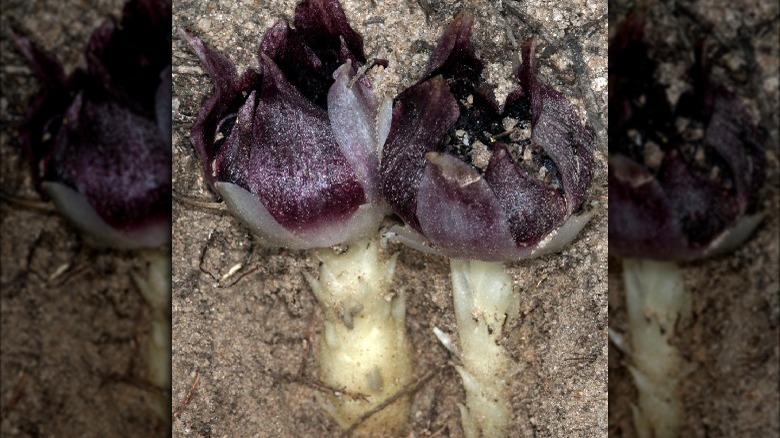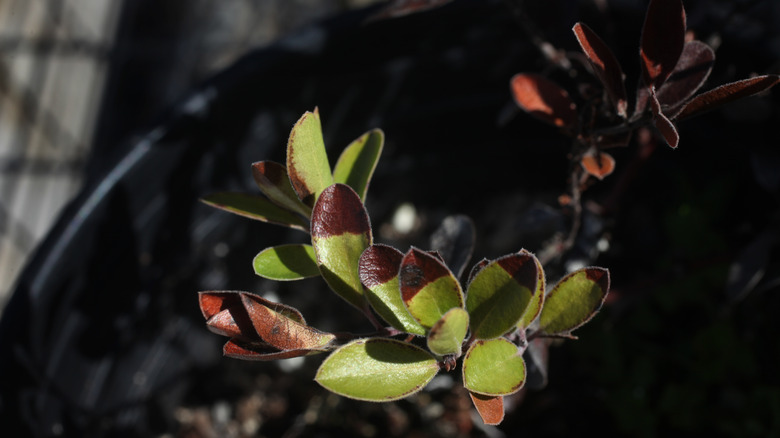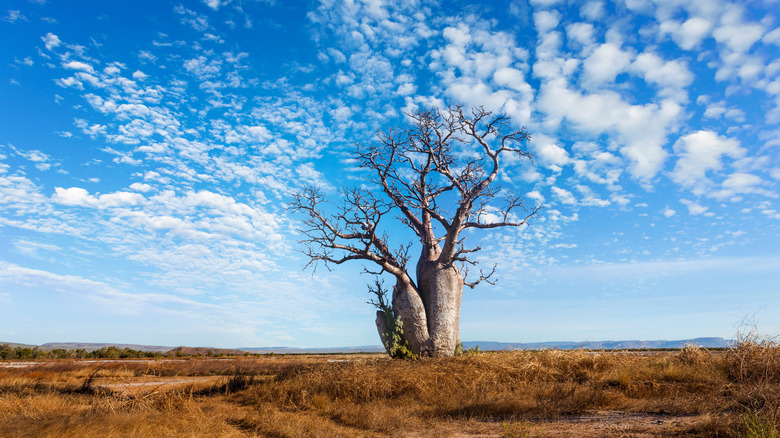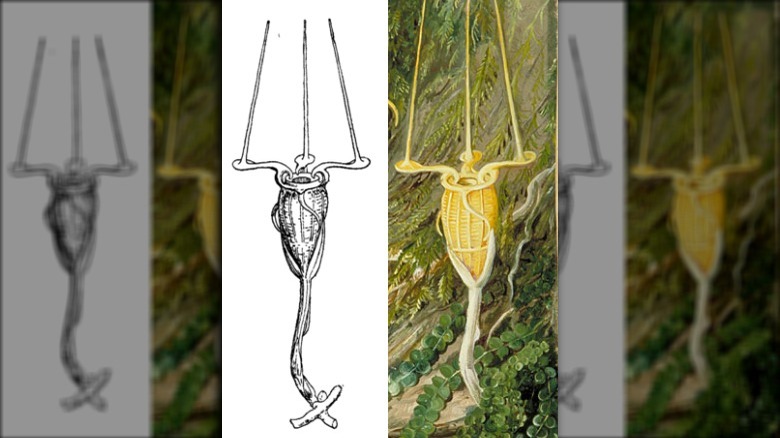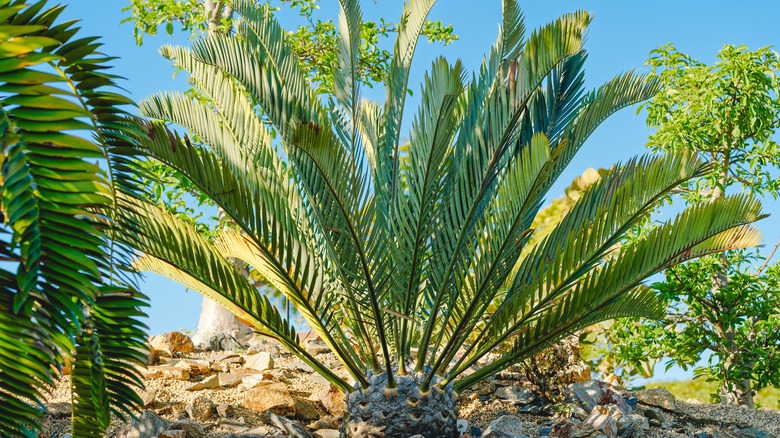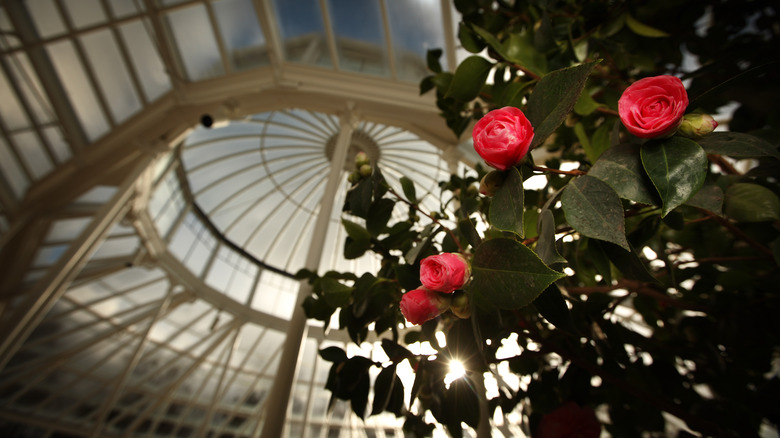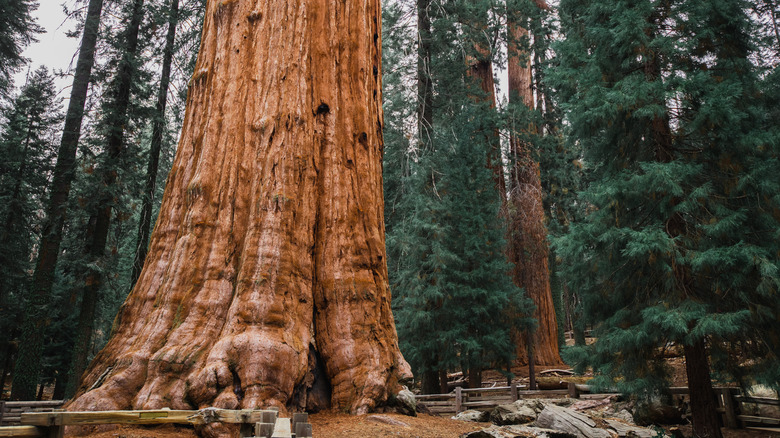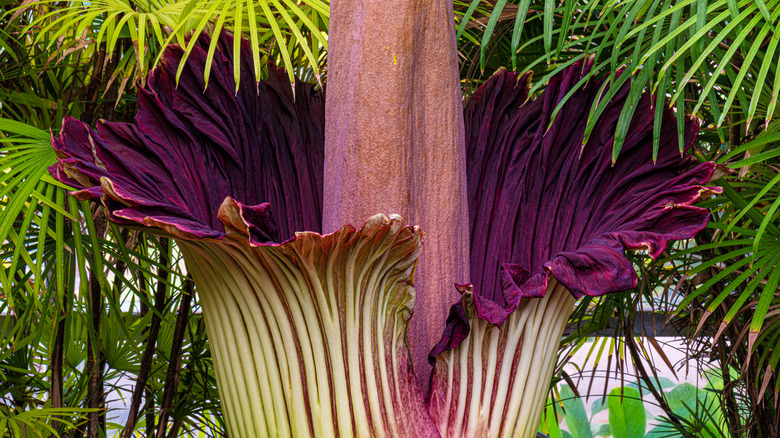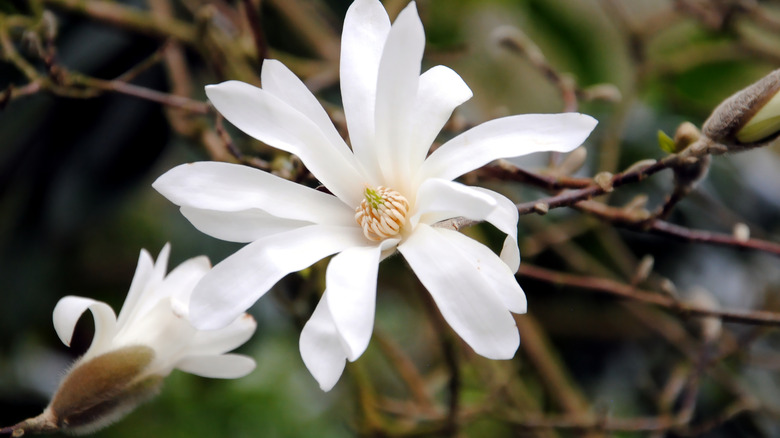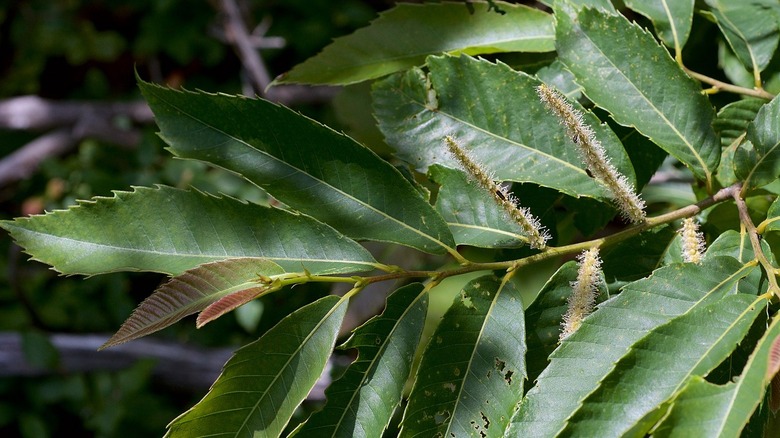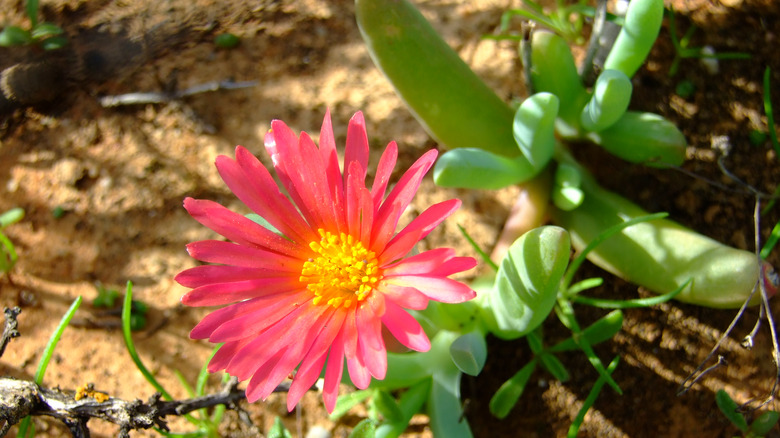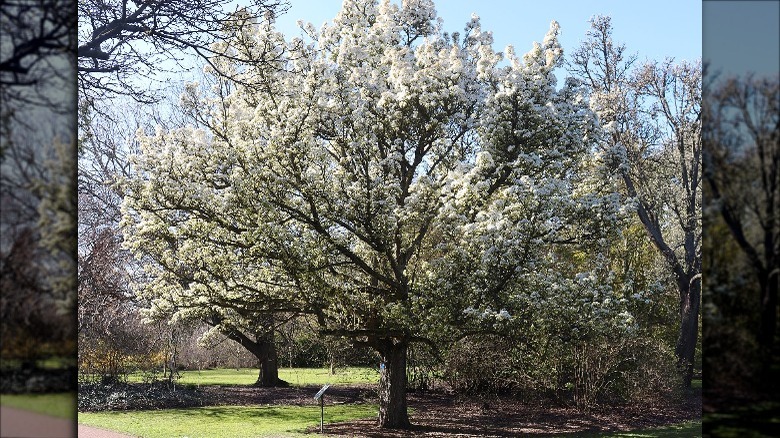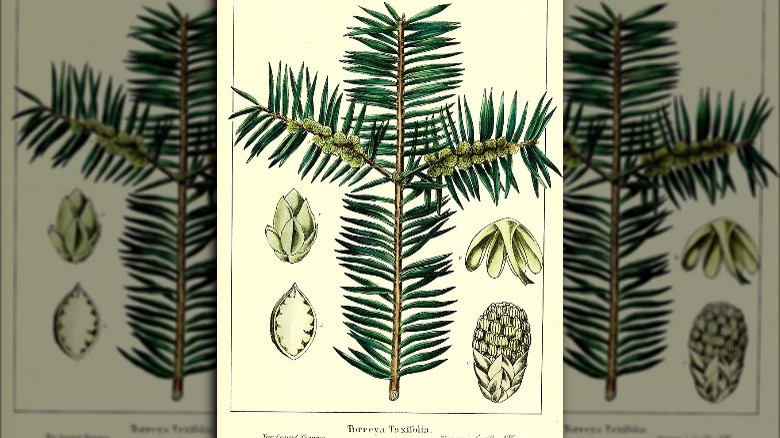Plants That Are Near Extinction
When we think of extinction, it's usually animals that come to mind first: There is, of course, the famous dodo bird, which went extinct due to a combination of habitat loss and predatory animals. There's plenty of cautionary tales, too, like the buffalo. These massive beasts were nearly hunted to extinction by European settlers who thought there was nothing more fun than shooting a bunch of animals... and that should be the dictionary definition of awful human behavior.
That's all proof of just how destructive the human race has been, and there's more: Today, plants are also going extinct at an alarming rate, too. Research published in 2019 by a group of scientists — from universities including (but not limited to) Stellenbosch University and the University of California, Davis — found (via The Conversation) that in our not-so-wonderful modern age, plants are "going extinct up to 350 times faster than the historical average." It's impossible to give exact numbers, but the UN has warned that somewhere around a million plant species are on the brink of extinction, and in a single article published in Nature in June 2019, 571 species had officially gone the way of the dodo.
While it's impossible to talk about all of them, let's talk about a handful of the plant species that are facing extinction — and you might be surprised.
These common houseplants aren't doing as well as most think
Cacti are one of those plants that every plant-lover has at least a dozen of, so how on earth can they be facing extinction?
In 2015, the International Union for the Conservation of Nature published some disturbing findings. In their study of the world's 1,480 different species of cactus, they found (via the BBC) that 31% were approaching extinction, particularly those living in extinction hotspots like the deserts of Chile and Brazil.
Why? Simply put: People are the worst. They found that 47% of those severely endangered species had been driven to near extinction in the wild because of black market demand. Illegal trade and harvesting have decimated a shocking number of species, some of which are highly desirable because of their unique flowers, while others are valued for their medicinal properties. Still other species of cacti are facing the final curtain thanks to changes in their habitats — mostly from agriculture and aquaculture. Add in the fact that cacti tend to grow very slowly, and it's led to cacti as a whole being named "the fifth most threatened species on [the] red list of endangered flora and fauna" (via The Guardian).
The medicinally valuable yew
The Himalayan Mountains are filled with a wide variety of beautiful, varied, and useful plants: According to The Times of India, at least 1,748 plants with medicinal properties have been found there. But their usefulness comes at a cost, and at least 112 are officially listed as "threatened."
That, says The Morton Arboretum, includes a tree called Maire's yew. At one time, it was found across Nepal, but as of 2020, there were only about 500 mature trees left in the wild.
That's largely because of a discovery made by the US National Cancer Institute back in the 1960s. They found that the bark of the yew contains a compound called Taxol, which is a crucial ingredient in chemotherapy drugs. Stripping off the bark kills the tree, but there's good news. Clippings are also a source of the compound, says The Guardian, so it's possible that small cuttings and saplings might be used to both produce the compound and keep the trees around. The problem, however, is the black market, and illegal trading that's fueled by those who harvest the trees — and their bark — at night and under the radar.
M. grandiflora and the extinction hotspot
The 3-foot-tall flower called Marshallia grandiflora — a massive member of the daisy family once popular throughout Appalachia — isn't the sort of thing that is easy to miss, which is why it's been said to be extinct since at least 1919. But it turns out that the story's more complicated than that.
Botanist Wesley Knapp calls M. grandiflora "presumably extinct," because he says (via The Revelator) there's still some — but not much — hope that it'll be found. In the meantime, the search for any signs of this species alerted botanists to another problem. The extinct species had been lumped in with another species of the plant — popularly known as Barbara's buttons — and when they started looking at this other species, they realized that it was no longer as widely found as it once had been.
Habitat loss led to the once widespread Marshallia pulchra being recommended for addition to the "vulnerable to extinction" section of the IUCN Red List, along with a third species. M. legrandii was, at the time, found only in a 4-square-mile section split between an area in North Carolina and Virginia. The decline and potential loss of these species — along with the extinction of several others — has led Knapp to call the entire area a "previously unrecognized extinction hotspot," and that's not a good thing.
America's lost apples
You can definitely find piles of apples at almost any grocery store, but the Smithsonian has some shocking numbers. Today, commercial apple production is spread across only 15 different varieties. Go back through North America's history, though, and you'll find that more than 17,000 varieties have been identified, named, and then — mostly — lost. No one's sure how many are extinct, but here's some numbers: the Temperate Orchard Conservancy has a program that includes 5,000 different apple varieties. That's a lot, but it's nowhere near how many the continent once had.
The good news is that there are people out there trying to find — and save — some of these lost varieties, like the Lost Apple Project. In 2020, they rediscovered specimens of 10 varieties previously thought extinct, and it involved a lot of hard work — starting with searching through old property maps and even interviewing anyone who might remember anything about old, local orchards and what kinds of apples were grown there.
There's one apple tree in particular that gets a special mention: the Algeo. In 2021, PR Newswire announced that thanks to the Algeo-Wilkins family, the last apple tree planted by Johnny Appleseed had been preserved, with genetically identical saplings going up for sale for the first time.
The rarest plant of the Seychelles
The distinctive features of the rarest tree of the Seychelles gave it both the official, scientific name of Medusagyne oppositifolia and the common name of the jellyfish tree. It's the female parts of the tree that bear a striking resemblance to either Medusa's snakes or the tentacles of the jellyfish, but according to the Eden Project, that very cool appearance hasn't helped it spread.
There's good and bad news with this one. According to the Seychelles News Agency, the tree was thought to be extinct for a long time. They'd seemingly disappeared at the turn of the 20th century, but a handful of trees were rediscovered in 1970. At the time a PhD student named Aline Finger had done some serious work on trying to figure out why the tree wasn't multiplying, it was estimated there were only about 100 trees left. In 2016, it was announced that the Royal Botanic Garden of Edinburgh was home to a jellyfish tree they'd been growing for 13 years, but it hasn't been all good news.
According to Our Breathing Planet, there are now only about 30 trees left in the wild. They occupy a very specific niche in their ecosystem and require a very particular sort of habitat — one that's found on the tiny island of Mahé — to thrive, and that's made them highly susceptible to the effects of climate change.
The aptly-named underground orchid
Some plants are just downright weird, and that's the case with the ultra-rare Rhizanthella gardneri, more commonly known as the underground orchid. It looks nothing like the orchids regularly seen at grocery and home stores across the country, and as the plant's name suggests, it lives entirely underground in the roots of the broom bush shrub, found in Western Australia. According to biologist Dr. Etienne Delannoy (via EarthSky), the orchid, the shrub, and a fungus commonly found in the shrub's roots exist in a symbiotic relationship, with one providing the nutrient and the other doing the photosynthesis.
Strangely, even though the orchid lives underground and doesn't have the capability of photosynthesis, it still has the chloroplasts usually associated with this basic life process of so many plants. That all makes it one of the strangest of the planet's 30,000-odd species of orchids, and it's also one of the rarest. CSIRO botanist Mark Clements says (via The Conversation) that the underground orchid was only discovered in 1928, and every species of underground orchid identified since then is severely endangered.
There's only about 50 specimens of R. gardneri left, for example, and the five locations where it's found are a closely guarded secret.
The strange circumstances that saved the last of a kind
When it comes to biodiversity, California is right up there. Sadly, that also means that the widespread development and habitat loss happening across the state is putting pressure on a wide range of species, and that's what happened to the Franciscan manzanita. The shrub was discovered in the 1800s near San Francisco, says In Defense of Plants, and it was — at the time — fortunate in that some enterprising botanists tried to save some of the shrubs from the relentless forward march of bulldozers clearing land for more and more cities. The so-called progress continued, and by the 1940s, the manzanita was declared extinct in the wild.
Fast forward to 2009, and yet another building project. Construction crews were replacing roads and cutting back vegetation, when a law enforcement officer parked his patrol car in their work zone. Bizarrely, that led to them skipping over an entire patch of greenery, and later, a botanist named Daniel Gluesenkamp noticed that one patch of land just happened to have the last remaining wild Franciscan manzanita on it. What are the chances?
The plant was moved, but without a mate, there's no chance of it reproducing. The National Park Service calls it one of the "loneliest plants," along with another single-specimen manzanita, the Raven's. Conservationists hope to find genetically diverse specimens growing in captivity to cross-pollinate with these sole survivors and — hopefully — they can save an entire species.
The slow death of the baobab
Baobabs are iconic, and there are few trees that look as distinctive, surreal, and otherworldly as these massive, ancient African giants. Unfortunately, it's looking more and more like their future is in doubt. In 2018, Scientific American reported that 13 baobab trees suddenly died, and it's a big deal — they were among the oldest known of their kind, estimated to be more than 2,000 years old. The die-off ironically occurred while researchers were studying the trees to find out how they managed to live for so long, and it was called (via Nature) "an event of unprecedented magnitude."
The heart of the problem, researchers found, is that they store a lot of water in those massive trunks, and changing weather patterns mean they don't have access to all the water they need... for the first time in millennia.
There are eight different species of baobab, and one — A. perrieri — has less than 100 individual trees left in the wild. They're also being impacted by shrinking habitats as well as the stresses of climate change, and researchers also say they're considering the fact that many of the animals that once spread the trees' seeds — like giant tortoises — have gone extinct. That all means that it's expected that not only will this species disappear, but another — A. suarezensis — will likely go extinct by 2080 if current trends continue.
The tale of two Thismia
Here's a super important lesson: It doesn't take much to destroy an entire species. Take the story of the weird, underground-dwelling, parasitic plant named Thismia americana by the botanist who discovered it in 1912. Real Clear Science says Norma Pfeiffer, a graduate student at the University of Chicago, was walking around Lake Calumet when she spotted a plant that was unlike anything she'd ever seen. It's no wonder: It flowered only briefly, and spent the rest of the time underground. She wrote her thesis on it, and then? It was gone.
The disappearance of the plant was linked to the construction of a nearby barn, and even though people head out to look for the plant every year — in the window of time when it should be flowering — it hasn't been rediscovered. That doesn't mean it won't be.
In 1866, the Italian botanist Odoardo Beccari was exploring the forests of Borneo when he discovered a parasitic plant he called Thismia neptunis (pictured). Like its Chicago cousin, it was a parasitic fungus that seemed to have disappeared... until botanists from the Crop Research Institution stumbled across it again... in 2017. They suggest there's only about 50 left in the world, but it gives us some hope that other Thismia species might be out there, too. Somewhere.
The 280-million year-old species we're close to killing
When John Medley Wood discovered a funky-looking tree in southern Africa in 1895, he noticed that it didn't really look like any of the other trees around it. That, says National Geographic, is because he had stumbled across the last remaining specimen of a tree that's now called E. woodii.
The tree is a member of the cycads, and cycads have been around for around 280 million years. They thrived during the Jurassic Period — when around 20% of trees were cycads — and they managed to survive global extinction and five Ice Ages. Today, relatives of the E. woodii are insanely popular. (A-list celebs like Brad Pitt and Oprah Winfrey have gardens full of them, with some trees selling for as much as $20,000 each.)
But E. woodii is all by his lonesome, and it is a "him." The tree Wood discovered was male, and fortunately, he had sent some stems to the Royal Botanical Gardens at Kew. Even as botanists continue to search for a female mate for the tree, the original specimen has been cloned. Can scientists create a female version of a cloned E. woodii? Maybe! Should they? That's a little tougher to answer. Without a female, though, it's the end of the line — and NatGeo calls him "the loneliest plant in the world."
The rarest camellia in the world
Cats, it's said, have nine lives. It's entirely possible that the flower The Guardian calls the "world's rarest camellia" might have even more lives than a cat. The flower is properly known as Middlemist's Red, and it's named after John Middlemist. He was in China at the beginning of the 1800s, and in 1804, he picked up the red camellia and gave it to conservators at Kew Gardens. They, weirdly, lost it.
Then, in 1823, a baby version of the flower was found. That was preserved by the sixth Duke of Devonshire, who happened to have a camellia collection, but here's where life number 2 vanishes: When the duke started renting out the property, his conservatory was ruined — and even more damage was done when World War II bombing got a little too close for comfort.
It wasn't until the 1980s that local volunteers set about rebuilding the conservatory and saving what plants remained — and among the ruins, they found Middlemist's red. Today, it's one of only two specimens of the camellia known to exist, and the International Camellia Society says the other is in New Zealand.
The slow death of America's most iconic trees
The towering monoliths of the West Coast are so big that photos of them definitely look doctored... but they're not, and sadly, these trees might not be around much longer. There are actually two different kinds of redwoods, the giant sequoias and the coast redwoods. General Sherman — the largest living thing in the world — is a sequoia, and he's 275 feet tall and around 2,100 years old (via the Poughkeepsie Journal). They're tough, but they're facing some tougher times.
In 2015, UC Berkeley professor Todd Dawson confirmed that drought conditions had dropped water levels to well below the depth of the roots of sequoia trees, and young trees in particular were suffering from water stress. At the time it wasn't clear just how bad it was going to get, but in 2020, it seemed like the answer was, "Pretty bad."
Since drought conditions started, The Guardian reported that dozens of the giant sequoias have died from a combination of stressors that include drought, damage from wildfires, and beetle infestations. For the first time, trees are recorded as dying "from top down," and while there are still around 6,000 left, the sudden deaths of these giants that have — until now — previously weathered everything that was thrown at them is incredibly worrying. National Park resource management officer Dr. Christy Brigham explained: "It's unheard of. It's never happened before. You think giant sequoias don't die in fire, you think giant sequoias can't be killed by insects. That's not true anymore."
One of the most famous flowers in the world is highly threatened
It's called the corpse flower because of the smell they give off when they flower, and they're also notable for having the largest flower of any flowering plant on the planet. That's pretty cool, so it's not surprising that whenever one of the specimens living at any botanical garden gets close to opening a rare bloom, it's a huge deal that attracts a ton of tourists.
They might be famous, but their numbers are dwindling — and there's a huge problem with the 500-odd corpse flowers that are kept in captivity, and the less than 1,000 wild ones: They're related, says Slate. (And those wild ones are under increasing pressure because of widespread habitat loss in their native Sumatra.)
Steps are being taken to try to preserve genetic diversity in what's left of the corpse flowers, and if it works, it could set a precedent for the preservation of other plants. A project spearheaded by the Chicago Botanic Garden is going to implement studbooks — which are essentially a genetic breeding registry styled after the ones used in the preservation of animal species — to create plant pedigrees that will then be used to make matches, with the goal of not just saving the corpse flower, but saving a genetically diverse species that can survive in the wild (via The New York Times).
So many magnolias
Magnolias have been around for a long time: According to the Caerhays Estate, they were first described in Europe in 1737, they were widely cultivated by the Aztec, and fossil records suggest they've been around for somewhere around 100 million years... give or take. There are still dozens of species that are common today, so where does this whole extinction thing come in?
In 2007, Bournemouth University's School of Conservation Sciences took a good, long look at all the various magnolia species, and found (via ScienceDirect) that 131 of 245 species are approaching extinction. That includes the seemingly popular star magnolia (pictured): According to the Journal of Forest Research, it's nearly extinct in the wild.
The good news is that their findings have boosted conservation efforts. In 2017, Flora and Fauna International reported that Vietnam's Magnolia grandis — which had dropped to just around 150 wild plants — was getting a major boost. As a part of their Global Trees Campaign, they raised and planted 1,100 seedlings on local cardamom farms for a double benefit: Not only was it going to help the magnolia, but the young trees were going to help protect delicate cardamom crops, too. It's a win-win, and hopefully, it'll be a story applied to other endangered magnolias, too.
The chestnut trees now safely hidden away
Way back in the middle of the 20th century, a deadly blight swept through the trees of the Ozarks. Among the casualties was the Castanea ozarkensis, or Ozark chinquapin, and new trees would immediately be infected with blight and die down to their roots.
It's entirely possible that could have been the end of a tree that National Geographic says was a "keystone" species, if a Missouri State Parks naturalist hadn't gotten involved. Steve Bost searched the forests of Missouri and Arkansas for any remaining trees, and found 45 of them. That's a far cry from the number of trees that were around just a few hundred years ago: Their chestnuts were a major food source for the Cherokee, who used them to make flour, and here's a fun fact: When the wood burns, there's no visible smoke, so it was a favorite of bootleggers trying to keep their still locations secret.
Now, with the help of those few remaining, resistant trees, Bost started a handful of "test plots" to see if he could bring the species back from the brink. It's a complicated process of collecting pollen, preparing it, and then driving to another healthy tree to play pollinator. He's careful to stress that no one has successfully brought a species back this way, but just because it hasn't been done, that doesn't mean that people shouldn't try — and if it works for this tree, it may work for others, too.
Richtersveld's rare succulents
The idea of poaching might bring up images of elephants or rhinos being hunted for their tusks and horns, but poachers are also doing some serious damage to plant populations, too. The Richtersveld National Park is a world heritage site in South Africa that botanists consider the "most biologically diverse desert in the world," and according to The Guardian, the unique plant life there has been hard hit by the double whammy of poaching and climate change.
The problem is that the area sits at the intersection of several different types of climate regions, and that means some of the area's plants can only grow in a very small area: Some are only found in patches no bigger than a football field. Add in a greedy poacher who's picking up everything they can find, and an entire species can go extinct in the wild in just a day. And it happens on a massive scale: In two 2019 and 2020 incidents, 75,000 illegally poached succulents were seized from poachers. Those succulents belonged to the Conophytum family, which contains around 30 critically threatened species.
Around 100 species found only in Richtersveld are considered to be threatened with immediate extinction, and they're facing other challenges, too. A climate that's getting increasingly drier means seeds and topsoil are being blown into the ocean, and water stress is impacting even low-maintenance succulents. Add in mining and the impacts of local farmers' very hungry goats, and things aren't looking promising.
The wild pear tree that's indicative of a larger problem
The Global Trees Campaign of Fauna & Flora International says that it's unclear just how many Bukharan pear trees are left, but does say that in the wild, they're only found in "a handful of inaccessible locations" in Central Asia. They also say that it's representative of a larger problem, and the trees of the region's rich forests — that once supplied locals with a wealth of fruit and nuts — have seen their numbers decline by as much as 90% in recent years.
And this isn't just some far-away plant that is never going to impact life in America, either — there's a good chance it might. The Bukharan pear is a close relative of the pears that are on the shelves of supermarkets across the globe, which means their genetic material could be a crucial weapon against new diseases that could pop up and threaten the stability of commercial pear production.
In short: The more diverse stock the world has access to, the better. FFI describes these wild populations as a "genetic reservoir," but fighting the threats to these populations — which include grazing, unsustainable harvesting, and grafting procedures that lead to hybridization — is an uphill battle. Fortunately, it's one that's punctuated by occasional good news: In 2018, researchers discovered 129 previously unknown trees that have helped in the creation of nurseries that will hopefully reverse the damage done to this wild fruit.
Christmas isn't a great time for everyone
The unfortunately-named stinking cedar was once one of the most populous trees across the southeastern US — and it had been there for a long time. According to the United States Botanic Garden, it's one of (if not the) oldest trees in the world, and it's been around for at least 165 million years. Until, that is, now.
Between the turn of the century and the 1950s, the stinking cedar was widely and freely harvested. It was a popular Christmas tree, it was used for building materials, and it was commonly used for fuel. The disappearance of larger trees couldn't have come at a worse time, and when fungal blight spread through the remaining population, the results were devastating.
Estimates suggest there are only a few hundred of these once-plentiful trees left, and the Global Trees Campaign of Fauna & Flora International says only about 0.3% of the original population remains. It's been considered endangered since 1984, and it's proving difficult to save. Trees that are replanted in their original habitat die from the same fungal infection that destroyed the population in the first place, and until conservationists can find a way to protect the tree from this devastating disease — and the deer who like to munch on it — they're concentrating on preserving seeds.
